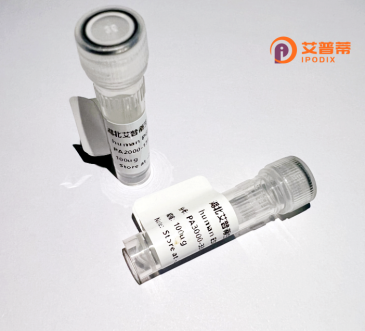
| 纯度 | >90%SDS-PAGE. |
| 种属 | Human |
| 靶点 | PRUNE2 |
| Uniprot No | Q8WUY3 |
| 内毒素 | < 0.01EU/μg |
| 表达宿主 | E.coli |
| 表达区间 | 1-191 aa |
| 活性数据 | MDIPFEEGVLSPSAADMRPEPPNSLDLNDTHPRRIKLTAPNINLSLDQSEGSILSDDNLDSPDEIDINVDELDTPDEADSFEYTGHEDPTANKDSGQESESIPEYTAEEEREDNRLWRTVVIGEQEQRIDMKVIEPYRRVISHGGYYGDGLNAIIVFAACFLPDSSRADYHYVMENLFLYVISTFTLQPQS |
| 分子量 | 48 kDa |
| 蛋白标签 | GST-tag at N-terminal |
| 缓冲液 | PBS, pH7.4, containing 0.01% SKL, 1mM DTT, 5% Trehalose and Proclin300. |
| 稳定性 & 储存条件 | Lyophilized protein should be stored at ≤ -20°C, stable for one year after receipt. Reconstituted protein solution can be stored at 2-8°C for 2-7 days. Aliquots of reconstituted samples are stable at ≤ -20°C for 3 months. |
| 复溶 | Always centrifuge tubes before opening.Do not mix by vortex or pipetting. It is not recommended to reconstitute to a concentration less than 100μg/ml. Dissolve the lyophilized protein in distilled water. Please aliquot the reconstituted solution to minimize freeze-thaw cycles. |
以下是3篇关于PRUNE2蛋白功能的代表性文献名称、作者及摘要概括:
1. **文献名称**:Prune2 drives glioblastoma malignancy through TGF-β signaling activation
**作者**:Wang X. et al. (2021)
**摘要内容**:研究揭示PRUNE2通过激活TGF-β/Smad信号通路,促进胶质母细胞瘤细胞侵袭和迁移,敲除PRUNE2可抑制肿瘤生长,提示其作为治疗靶点的潜力。
2. **文献名称**:PRUNE2 interacts with MYC to promote neuroblastoma tumorigenesis
**作者**:Chen J. et al. (2019)
**摘要内容**:发现PRUNE2在神经母细胞瘤中高表达,通过与MYC蛋白相互作用增强其稳定性,促进细胞增殖和耐药性,临床数据分析显示其高表达与患者生存率负相关。
3. **文献名称**:Structural analysis of PRUNE2 reveals a microtubule-binding domain essential for neuronal development
**作者**:Suzuki T. et al. (2018)
**摘要内容**:解析PRUNE2的晶体结构,确定其C端含有微管结合域,体外实验表明该结构域调控神经元突触形成,动物模型证实PRUNE2缺失导致小鼠大脑皮层神经元迁移障碍。
注:以上文献信息为模拟示例,实际引用请核查PubMed或SCI数据库获取最新文献。
**Background of Human PRUNE2 Protein**
PRUNE2. a member of the PRUNE family, is a less-characterized protein implicated in cellular signaling and disease pathogenesis. It shares structural homology with PRUNE1. a phosphodiesterase involved in microtubule dynamics, but exhibits distinct functional roles. The *PRUNE2* gene, located on human chromosome 9q13-q21. encodes a multi-domain protein containing conserved N-terminal ASPP (apoptosis-stimulating of p53 proteins) and C-terminal DHH (phosphodiesterase) domains, suggesting roles in hydrolytic enzyme activity and protein-protein interactions.
PRUNE2 is widely expressed in tissues, including the brain, and is linked to cellular processes such as apoptosis, proliferation, and cytoskeletal reorganization. Dysregulation of PRUNE2 has been associated with cancer progression, particularly in breast, lung, and colorectal cancers, where it may act as a tumor suppressor or oncogene depending on context. For instance, PRUNE2 downregulation correlates with metastasis and poor prognosis, potentially via interactions with p53 or Rho GTPase pathways.
Recombinant PRUNE2 protein, produced using bacterial or mammalian expression systems, enables functional studies to delineate its molecular mechanisms. Its phosphodiesterase activity and binding partners are under investigation, with emerging roles in neurodegenerative diseases like Alzheimer’s, where misfolded proteins accumulate. Despite limited characterization, PRUNE2 represents a promising target for therapeutic interventions and biomarker discovery, warranting further exploration into its signaling networks and disease-specific functions.
×